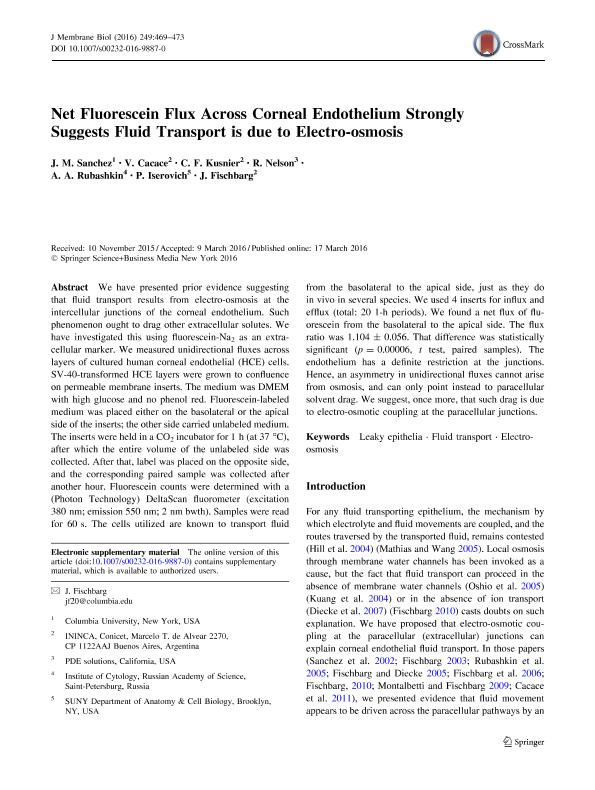Mostrar el registro sencillo del ítem
dc.contributor.author
Sanchez, J. M.
dc.contributor.author
Cacace, Verónica Inés

dc.contributor.author
Kusnier, Carlos Federico

dc.contributor.author
Nelson, R.
dc.contributor.author
Rubashkin, A. A.
dc.contributor.author
Iserovich, P.
dc.contributor.author
Fischbarg, Jorge

dc.date.available
2018-03-15T18:19:02Z
dc.date.issued
2016-08
dc.identifier.citation
Sanchez, J. M.; Cacace, Verónica Inés; Kusnier, Carlos Federico; Nelson, R.; Rubashkin, A. A.; et al.; Net Fluorescein Flux Across Corneal Endothelium Strongly Suggests Fluid Transport is due to Electro-osmosis; Springer; Journal of Membrane Biology; 249; 4; 8-2016; 469-473
dc.identifier.issn
0022-2631
dc.identifier.uri
http://hdl.handle.net/11336/38959
dc.description.abstract
We have presented prior evidence suggesting that fluid transport results from electro-osmosis at the intercellular junctions of the corneal endothelium. Such phenomenon ought to drag other extracellular solutes. We have investigated this using fluorescein-Na2 as an extracellular marker. We measured unidirectional fluxes across layers of cultured human corneal endothelial (HCE) cells. SV-40-transformed HCE layers were grown to confluence on permeable membrane inserts. The medium was DMEM with high glucose and no phenol red. Fluorescein-labeled medium was placed either on the basolateral or the apical side of the inserts; the other side carried unlabeled medium. The inserts were held in a CO2 incubator for 1 h (at 37 °C), after which the entire volume of the unlabeled side was collected. After that, label was placed on the opposite side, and the corresponding paired sample was collected after another hour. Fluorescein counts were determined with a (Photon Technology) DeltaScan fluorometer (excitation 380 nm; emission 550 nm; 2 nm bwth). Samples were read for 60 s. The cells utilized are known to transport fluid from the basolateral to the apical side, just as they do in vivo in several species. We used 4 inserts for influx and efflux (total: 20 1-h periods). We found a net flux of fluorescein from the basolateral to the apical side. The flux ratio was 1.104 ± 0.056. That difference was statistically significant (p = 0.00006, t test, paired samples). The endothelium has a definite restriction at the junctions. Hence, an asymmetry in unidirectional fluxes cannot arise from osmosis, and can only point instead to paracellular solvent drag. We suggest, once more, that such drag is due to electro-osmotic coupling at the paracellular junctions.
dc.format
application/pdf
dc.language.iso
eng
dc.publisher
Springer

dc.rights
info:eu-repo/semantics/openAccess
dc.rights.uri
https://creativecommons.org/licenses/by-nc-sa/2.5/ar/
dc.subject
Electro-Osmosis
dc.subject
Fluid Transport
dc.subject
Leaky Epithelia
dc.subject.classification
Otras Ciencias Biológicas

dc.subject.classification
Ciencias Biológicas

dc.subject.classification
CIENCIAS NATURALES Y EXACTAS

dc.title
Net Fluorescein Flux Across Corneal Endothelium Strongly Suggests Fluid Transport is due to Electro-osmosis
dc.type
info:eu-repo/semantics/article
dc.type
info:ar-repo/semantics/artículo
dc.type
info:eu-repo/semantics/publishedVersion
dc.date.updated
2018-03-15T14:07:24Z
dc.journal.volume
249
dc.journal.number
4
dc.journal.pagination
469-473
dc.journal.pais
Alemania

dc.journal.ciudad
Berlín
dc.description.fil
Fil: Sanchez, J. M.. Columbia University; Estados Unidos
dc.description.fil
Fil: Cacace, Verónica Inés. Consejo Nacional de Investigaciones Científicas y Técnicas. Oficina de Coordinación Administrativa Houssay. Instituto de Investigaciones Cardiológicas. Universidad de Buenos Aires. Facultad de Medicina. Instituto de Investigaciones Cardiológicas; Argentina
dc.description.fil
Fil: Kusnier, Carlos Federico. Consejo Nacional de Investigaciones Científicas y Técnicas. Oficina de Coordinación Administrativa Houssay. Instituto de Investigaciones Cardiológicas. Universidad de Buenos Aires. Facultad de Medicina. Instituto de Investigaciones Cardiológicas; Argentina
dc.description.fil
Fil: Nelson, R.. PDE solutions; Estados Unidos
dc.description.fil
Fil: Rubashkin, A. A.. Russian Academy of Science; Rusia
dc.description.fil
Fil: Iserovich, P.. State University of New York; Estados Unidos
dc.description.fil
Fil: Fischbarg, Jorge. Consejo Nacional de Investigaciones Científicas y Técnicas. Oficina de Coordinación Administrativa Houssay. Instituto de Investigaciones Cardiológicas. Universidad de Buenos Aires. Facultad de Medicina. Instituto de Investigaciones Cardiológicas; Argentina
dc.journal.title
Journal of Membrane Biology

dc.relation.alternativeid
info:eu-repo/semantics/altIdentifier/url/http://link.springer.com/article/10.1007%2Fs00232-016-9887-0
dc.relation.alternativeid
info:eu-repo/semantics/altIdentifier/doi/http://dx.doi.org/10.1007/s00232-016-9887-0
Archivos asociados
